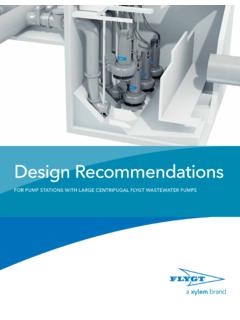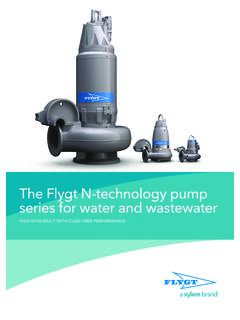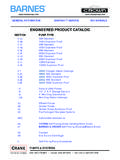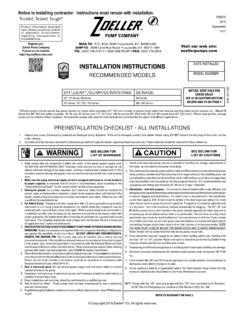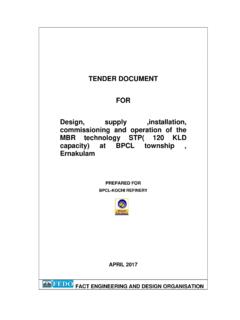Transcription of THE COMPLETE GUIDE TO Stormwater Management
1 Stormwater ManagementTHE COMPLETE GUIDE TO2 | THE COMPLETE GUIDE TO Stormwater MANAGEMENTW elcome consultants, civil and application engineers, planners and users of Stormwater systems around the have created this detailed GUIDE to outline the many ways in which we can help you resolve some of the most challenging scenarios related to Stormwater Management , flood prevention and relief. In our view this is achieved through smart pump station design, innovative solutions, state of the art equipment and capacity utilization with network more than 100 years, our engineers have resolved issues ranging from compact, cost-efficient pump sump station design, correct pumping duty conditions and monitoring and control requirement, to data collection and analysis, as well as tailor-made Stormwater projects. Some examples of their work are highlighted throughout this objective of sharing all this information is to give you answers and guidance into how to maximize a community s capacity to manage Stormwater .
2 This is our way to contribute to eliminate the danger to people, property and the environment that severe Stormwater events can hope you find this resource useful and welcome your feedback. Comments and inquiries can be sent through your local Xylem sales engineer or contact information on our website: Brannemo President, Transport and Treatment, | THE COMPLETE GUIDE TO Stormwater MANAGEMENTT able of Contents2 TABLE OF CONTENTS046 | THE COMPLETE GUIDE TO Stormwater MANAGEMENTOver the last 50 years, the global urban population has grown from to billion. Stormwater Management Trends and ChallengesHalf a century from now, our global urban population is projected to reach seven ,2 In the meantime, changes to global climate patterns are causing more intense rainfall and pronounced droughts. Although modern cities have the necessary infrastructure in place to control the resulting Stormwater , often the systems they have in place are outdated and not designed for a long service cities continue to operate conveyance structures, which contain parts that are multiple decades old; implemented before planners became aware of the issues of climate change and rapid urban expansion.
3 Today, urban growth and increasingly intense rainfall events cause these systems to be overloaded, resulting in frequent and serious forward, Stormwater control infrastructure will be required to live up to the challenges of population growth and climate change. It will also need to function properly in a world in which urban densification will make less space available for the implementation of Stormwater control solutions. From an engineering perspective, Stormwater assets will need to be considered in a broader is a prime example of this. In the last decade, Denmark s capital city and home to over million people has suffered flood damage in excess of one billion As a result, the city brought together specialists from many different disciplines to develop a 20-year plan aimed at improving water resilience. Copenhagen s plan integrates a wide variety of solutions for flood protection and recreational Stormwater usage; it also includes measures such as building blue and green streets and parks, constructing rain gardens and using roads as open waterways for extreme Stormwater relief.
4 The infrastructure needed for urban Stormwater control is significant in terms of both scale and expense, and it can t be replaced on a whim. It is built for a century of intended service life and requires long-term planning. Meanwhile, continuous upgrading and refining of this infrastructure will be critical to solving acute issues on the fly without undermining long-term planning goals. This requires an in-depth understanding of every aspect of your Stormwater control system, from the technical details of complex system interactions, to knowledge of the socio-economic and public perception implications. The only way for modern cities to meet present and future water productivity, water quality and water resilience needs is to implement the best available technologies in a resilient, long-term planning VollertsenProfessor, Institut for Byggeri og Anl gThomas Manns Vej 23 Lokale: 1-258 9220 Aalborg , DK71 2 3 | THE COMPLETE GUIDE TO Stormwater MANAGEMENTD efining Stormwater ManagementIn rural environments, a majority of rainfall infiltrates into the ground, while some excess slowly forms runoff streams or watercourses.
5 In cities and other urban spaces, rainfall collects rapidly and becomes runoff as the impervious surfaces of streets, paved areas and rooftops prevent it from infiltrating into the events also impact bodies of water, such as rivers and lakes, causing their water levels to rise periodically. Since many urban centers are built in the vicinity of these bodies of water, measures must be taken to prevent them from Management refers to the way in which these flows, and their potential pollutants (sand, chlorides, organic matter and even large objects), can best be managed using a wide range of solutions. It covers a broad spectrum of activities, from planning and measurement, to monitoring and control, as well as pumping and treatment. It includes infrastructure such as gutters, conduits and trenches, in addition to detention tanks, large and small pump stations and treatment plants.
6 Continue reading to discover what successful Stormwater Management looks like in urban spaces, and how the right solution can help you effectively improve water resilience in any | THE COMPLETE GUIDE TO Stormwater MANAGEMENTW ater is a vital resource that is deeply integrated into urban OneExamining Stormwater Management in Dense Urban EnvironmentsSponge CitiesTo accommodate rapid urban migration and development, some countries are turning to sponge city sponge city concept proposes the implementation of sustainable and ecological flood control methods with minimal footprint and energy consumption. It employs ecological principles, landscape architecture approaches and key techniques of infiltration, pumping, storage, purification, utilization and discharge. These techniques are applied through best Management practices (BMPs) and green Stormwater infrastructures (GSI) with low impact, as decided by each of the most ambitious sponge city programs is being developed in China, which launched pilot cases in 16 different cities in 2015 and plans to roll the scheme out nationally.
7 To assist in sponge city development, the Chinese government provides annual funding to qualified cities and municipalities across 2020, China hopes that 80% of its urban areas will be able to absorb and re-use at least 70% of spite of this, urbanization can radically change the flow of water and create a range of adverse effects, such as frequent, severe floods and changes in water quality. Around the world, urban water managers are constantly dealing with these issues, as well as other new and unprecedented challenges posed by Stormwater events. Investing in an efficient Stormwater collection system, applying best Management practices (BMPs) and implementing the right pumping storage and treatment infrastructures can help these individuals protect their communities from evolving natural hazards. 114 5 | SELECTING THE RIGHT Stormwater CONTROL SOLUTIONCOMBINED SEWER SYSTEM VERSUS SEPARATE SEWER SYSTEM Begin your evaluation of urban Stormwater control solutions by identifying which type of sewer system your community has in place.
8 Sewer systems can either be combined or separate, and each type comes with different risks and sewers, for example, are designed to collect both wastewater and Stormwater through a single pipe system. Separate sewers consist of two isolated pipe systems one for wastewater and another for Stormwater . In a separate system, Stormwater is conveyed to a designated outfall and commonly discharged directly into the receiving water. In a combined system, the flow of Stormwater and wastewater is directed to a treatment plant prior to being released to natural figures below show the potentially severe environmental consequences of a combined system overflow. In the event of heavy precipitation or snow meltdown, large quantities of mixed and untreated Stormwater and wastewater may be released into nearby bodies of a comprehensive review of your community s current sewer system as the foundation for making decisions regarding efficient Stormwater collection, detention or retention, transport to a treatment plant and Sewer Overflow (CSO)Combined Sewer System (CSS)12 | SELECTING THE RIGHT Stormwater CONTROL SOLUTIONPart OneExamining Stormwater Management in Dense Urban EnvironmentsSTORMWATER DISINFECTION Rain events can cause combined sewer overflows (CSOs) when conveyance systems or treatment plants are overwhelmed by Stormwater .
9 In addition to polluted runoff, CSOs contain pollutants and pathogens from raw sewage that pose potentially serious environmental and public health risks. Separate Stormwater systems may also contain pollutants and pathogens if they contain illegal connections and dumps, leakages, or if the flushing effluent is the case of both combined and separate systems, disinfection inactivates pathogens, making the released water significantly safer. Ozone and UV treatment are among the most efficient methods for disinfecting water. They are more effective than traditional chlorine-based methods and do not form disinfection by-products (DBPs). Modify and implement various wastewater disinfection methods to treat Stormwater before it is released back into the environment. Xylem s WEDECO brand offers a range of products and extensive expertise in water disinfection.
10 Please contact your local Xylem office for more information and a detailed consultation. For reference and case stories, see our Case Studies and White Papers section on our global Sewer Overflow (SSO)Separate Sewer System (SSS)1314 | MAXIMIZE SYSTEM EFFICIENCY WITH SMART PUMP STATION DESIGNPart OneExamining Stormwater Management in Dense Urban EnvironmentsOPTIMIZATION OF URBAN WATERSHED SYSTEMS Over the last few decades hydraulic and hydrological models have dramatically increased our understanding of urban watersheds for infrastructure with tools like the Internet on Things (IoT), Big Data Analytics (BDA), machine learning and advanced control theory algorithms we can now run high resolution models in real-time, with real world precipitation data, while controlling model segments with observed sensor data. The outcome is perpetually calibrated digital copies of the urban watershed for far more effective real-time operational decision making and control.


